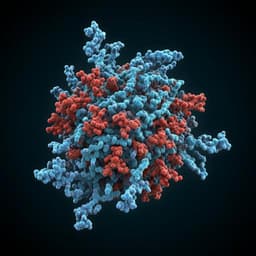
Medicine and Health
Mechanism of action for small-molecule inhibitors of triacylglycerol synthesis
X. Sui, K. Wang, et al.
Explore the groundbreaking findings on DGAT1, an enzyme crucial for triacylglycerol synthesis, and discover how inhibitors T863 and DGAT1IN1 operate in distinct ways. This study, conducted by Xuewu Sui and colleagues, sheds light on the selective inhibition mechanisms relevant to metabolic diseases and future therapeutic developments.
~3 min • Beginner • English
Introduction
Triacylglycerols (TGs) are a major storage form of metabolic energy, and dysregulated TG metabolism is associated with obesity, cardiovascular disease, diabetes, and various cancers. Overproduction of TGs and lipid droplet accumulation can promote cancer cell survival and growth, suggesting that inhibiting TG synthesis may offer therapeutic benefit. DGAT1 is one of two human enzymes that catalyze TG synthesis at the endoplasmic reticulum by esterifying diacylglycerol with acyl-CoA. This reaction is important for energy storage and for mitigating ER stress from excess fatty acids. DGAT1 belongs to the membrane-bound O-acyltransferase (MBOAT) family, whose members have conserved catalytic residues (His and Asn/Asp) deeply embedded in the membrane and an acyl-CoA access tunnel from the cytosol. Despite the development of DGAT1 inhibitors, the structural mechanisms by which these compounds inhibit DGAT1 and how selectivity among related MBOATs (e.g., ACAT1) is achieved remained unclear. This study aims to elucidate the mechanisms of action of small-molecule DGAT1 inhibitors and the structural basis of selectivity.
Literature Review
Methodology
The authors determined cryo-EM structures of human DGAT1 bound to the inhibitors T863 and DGAT1IN1. Human DGAT1 with an N-terminal MBP tag was expressed in HEK293 GnTI− cells via BacMam, purified using amylose affinity, TEV cleavage, and size-exclusion chromatography in digitonin, and reconstituted into PMAL-C8 amphipol in the continuous presence of inhibitor. Cryo-EM grids were prepared on Quantifoil R1.2/1.3 copper grids and imaged on Talos Arctica or Titan Krios microscopes with SerialEM. Data processing involved MotionCor2 for drift correction, CTFFIND4 for CTF estimation, 2D/3D classification and refinement in RELION, local resolution estimation with ResMap, and postprocessing with B-factor sharpening. Models were built by real-space refinement in PHENIX starting from PDB 6VYI, manual adjustment in COOT, ligand fitting using GRADE-generated restraints, and validation with MolProbity; protein–ligand interactions were analyzed with LigPlot and figures prepared in UCSF Chimera. DGAT1 enzymatic activity assays with purified protein were used to derive dose-response curves and IC50 values for T863 and DGAT1IN1 in digitonin-containing buffers. Cellular effects were examined by treating SUM159 cells with inhibitors before oleate loading, followed by lipid droplet staining (BODIPY 493/503) and quantification via ImageJ using threshold-based LD and cytoplasm masks. To probe selectivity, human ACAT1 (WT and mutants) was expressed transiently in HEK293F cells, microsomes were prepared by differential centrifugation, and ACAT1 activity was measured using [14C]-oleoyl-CoA tracer and cholesterol substrate in phosphatidylcholine micelles with TLC-based product quantification. Sensitivity of ACAT1 to T863, DGAT1IN1, and the ACAT1 inhibitor ATR101 was assessed; effects of specific residue substitutions (e.g., ACAT1 N487A; reciprocal DGAT1 A441N) on inhibitor sensitivity were evaluated. Statistical analyses employed one-way ANOVA.
Key Findings
- Cryo-EM structures at ~3.2 Å resolution revealed that both T863 and DGAT1IN1 bind within the cytosol-facing fatty acyl-CoA tunnel of DGAT1, competing with substrate access and thereby inhibiting TG synthesis.
- T863 occupies the entrance of the acyl-CoA tunnel, engaging DGAT1 through hydrophobic contacts (e.g., Tyr390, Ile386, Val407, Phe408, Gln375, His382) and hydrogen bonds (e.g., Ser411; main-chain carbonyls of Trp374 and Trp377). The bulky heterocycle contacts catalytic residues His415 and Asn378 via hydrophobic interactions. The carboxylate group density is weak, likely due to radiation damage.
- DGAT1IN1 shares the T863 scaffold but extends deeper (~1.2 Å) into the tunnel. Its amide linkage between the shared scaffold and a bulky (trifluoromethoxy)benzene moiety forms hydrogen bonds with conserved Trp377 and catalytic residues His415 and Asn378, effectively locking the inhibitor in the catalytic center. The distal bulky moiety makes hydrophobic contacts without apparent polar interactions.
- Biochemical assays with purified DGAT1 showed potent, dose-dependent inhibition by both T863 and DGAT1IN1; in cells, pre-treatment reduced lipid droplet area by about 50% under oleate loading.
- Selectivity: T863 did not significantly inhibit ACAT1 activity in microsomes, whereas the ACAT1 inhibitor ATR101 fully inhibited ACAT1. Structural comparison indicates a more constricted acyl-CoA entry in ACAT1 due to a distinct TM8/TM9 loop conformation and Asn487 protruding into the tunnel, causing steric clashes with T863.
- Mutagenesis validated the selectivity mechanism: ACAT1 N487A remained functional but became substantially (approximately 40%) more sensitive to T863; DGAT1IN1 inhibited ACAT1 more than T863 and its potency further increased with ACAT1 N487A. Conversely, introducing Ala441Asn in DGAT1 reduced T863 potency without affecting DGAT1 activity.
- The findings support two inhibitor classes for MBOATs: Type I inhibitors (e.g., T863, DGAT1IN1, LGK974) compete at the acyl-CoA tunnel from the cytosol; Type II inhibitors (e.g., XP620 for DGAT1; ATR101 and possibly pyripyropene A for ACATs) likely access the catalytic center via a lateral membrane gate to block acyl-acceptor binding.
- An amide group positioned between two hydrophobic moieties emerges as a common pharmacophore across MBOAT inhibitors, engaging conserved catalytic His/Asn residues to achieve potent inhibition and offering a scaffold for selective inhibitor design.
Discussion
The study addresses how small-molecule inhibitors block DGAT1 and how selectivity among related MBOATs is achieved. High-resolution cryo-EM structures demonstrate that T863 and DGAT1IN1 act as competitive inhibitors at the acyl-CoA tunnel, explaining their biochemical potency and cellular suppression of lipid droplet formation. DGAT1IN1’s deeper insertion and amide-mediated hydrogen bonding to His415 and Asn378 provide a structural rationale for stronger engagement of the catalytic center. Comparative structural analysis with ACAT1 reveals that subtle differences at the cytosolic tunnel entrance—particularly the TM8/TM9 loop conformation and Asn487—control access and thus selectivity. Mutational swapping confirms that single-residue changes can toggle sensitivity, underscoring that while MBOATs share conserved catalytic cores, the acyl-CoA binding tunnels differ sufficiently to enable selective targeting. The classification into Type I (acyl-CoA tunnel competitors) and Type II (lateral gate blockers) inhibitors integrates prior observations (e.g., LGK974, ATR101, pyripyropene A) and clarifies distinct routes to the active site. The identification of an amide-based pharmacophore engaging catalytic His/Asn suggests a generalizable strategy for designing inhibitors against multiple MBOATs, with side-chain variations near the amide conferring enzyme selectivity.
Conclusion
This work provides a structural foundation for the mechanism of action of DGAT1 inhibitors. Cryo-EM structures show that T863 and DGAT1IN1 occupy the acyl-CoA binding tunnel, with DGAT1IN1’s amide forming key hydrogen bonds to catalytic residues, rationalizing inhibition potency. Structural comparisons and mutational analyses explain inhibitor selectivity between DGAT1 and ACAT1 and reveal that single-residue differences at the tunnel entrance can modulate sensitivity. The results propose two mechanistic classes of MBOAT inhibitors (acyl-CoA tunnel competitors versus lateral gate blockers) and identify an amide-linked scaffold as a broadly applicable pharmacophore for MBOAT inhibition. Future work should quantify structure–activity relationships for diverse amide-centered scaffolds across MBOATs, resolve additional inhibitor-bound structures (including Type II compounds) to refine selectivity determinants, and assess in vivo efficacy and safety profiles to translate these insights into therapeutics.
Limitations
- The EM densities for certain inhibitor moieties (e.g., T863 carboxylate; DGAT1IN1 carboxylate and trifluoroethane ends) were weak or unresolved, likely due to radiation damage or flexibility, limiting detailed interaction assignments for these groups.
- Biochemical selectivity testing focused primarily on ACAT1; broader profiling across other MBOAT family members was not reported.
- Cellular data were limited to lipid droplet reduction in a single cell line and condition; comprehensive cellular and in vivo pharmacology and tolerability were not addressed.
- IC50 values were determined but not detailed in the text provided; dose–response examples represent single experiments with technical replicates, which may not capture full variability.
- Cryo-EM captures static conformations and may not fully reflect dynamic aspects of substrate/inhibitor access through the acyl-CoA tunnel or lateral gate.
Related Publications
Explore these studies to deepen your understanding of the subject.







